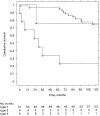Gastric carcinoids: biologic behavior and prognosis after differentiated treatment in relation to type
- PMID: 15973103
- PMCID: PMC1357706
- DOI: 10.1097/01.sla.0000167862.52309.7d
Gastric carcinoids: biologic behavior and prognosis after differentiated treatment in relation to type
Abstract
Objective: To analyze tumor biology and the outcome of differentiated treatment in relation to tumor subtype in patients with gastric carcinoid.
Background: Gastric carcinoids may be subdivided into ECL cell carcinoids (type 1 associated with atrophic gastritis, type 2 associated with gastrinoma, type 3 without predisposing conditions) and miscellaneous types (type 4). The biologic behavior and prognosis vary considerably in relation to type.
Methods: A total of 65 patients from 24 hospitals (51 type 1, 1 type 2, 4 type 3, and 9 type 4) were included. Management recommendations were issued for newly diagnosed cases, that is, endoscopic or surgical treatment of type 1 and 2 carcinoids (including antrectomy to abolish hypergastrinemia) and radical resection for type 3 and 4 carcinoids.
Results: Infiltration beyond the submucosa occurred in 9 of 51 type 1, 4 of 4 type 3, and 7 of 9 type 4 carcinoids. Metastases occurred in 4 of 51 type 1 (3 regional lymph nodes, 1 liver), the single type 2 (regional lymph nodes), 3 of 4 type 3 (all liver), and 7 of 9 type 4 carcinoids (all liver). Of the patients with type 1 carcinoid, 3 had no specific treatment, 40 were treated with endoscopic or surgical excision (in 10 cases combined with antrectomy), 7 underwent total gastrectomy, and 1 underwent proximal gastric resection. Radical tumor removal was not possible in 2 of 4 patients with type 3 and 7 of 9 patients with type 4 carcinoid. Five- and 10-year crude survival rates were 96.1% and 73.9% for type 1 (not different from the general population), but only 33.3% and 22.2% for type 4 carcinoids.
Conclusion: Subtyping of gastric carcinoids is helpful in the prediction of malignant potential and long-term survival and is a guide to management. Long-term survival did not differ from that of the general population regarding type 1 carcinoids but was poor regarding type 4 carcinoids.
Figures
References
-
- Modlin IM, Lye KD, Kidd M. A 50-year analysis of 562 gastric carcinoids: small tumor or larger problem? Am J Gastroenterol. 2004;99:23–32. - PubMed
-
- Soga J. Gastric carcinoids: a statistical evaluation of 1,094 cases collected from the literature. Surg Today. 1997;27:892–901. - PubMed
-
- Hakanson R, Owman C. Concomitant histochemical demonstration of histamine and catecholamines in enterochromaffin-like cells of gastric mucosa. Life Sci. 1967;6:759–766. - PubMed
-
- Solcia E, Rindi G, Silini E, et al. Enterochromaffin-like (ECL) cells and their growths: relationships to gastrin, reduced acid secretion and gastritis. Baillieres Clin Gastroenterol. 1993;7:149–165. - PubMed
Publication types
MeSH terms
Substances
LinkOut - more resources
Full Text Sources
Medical


